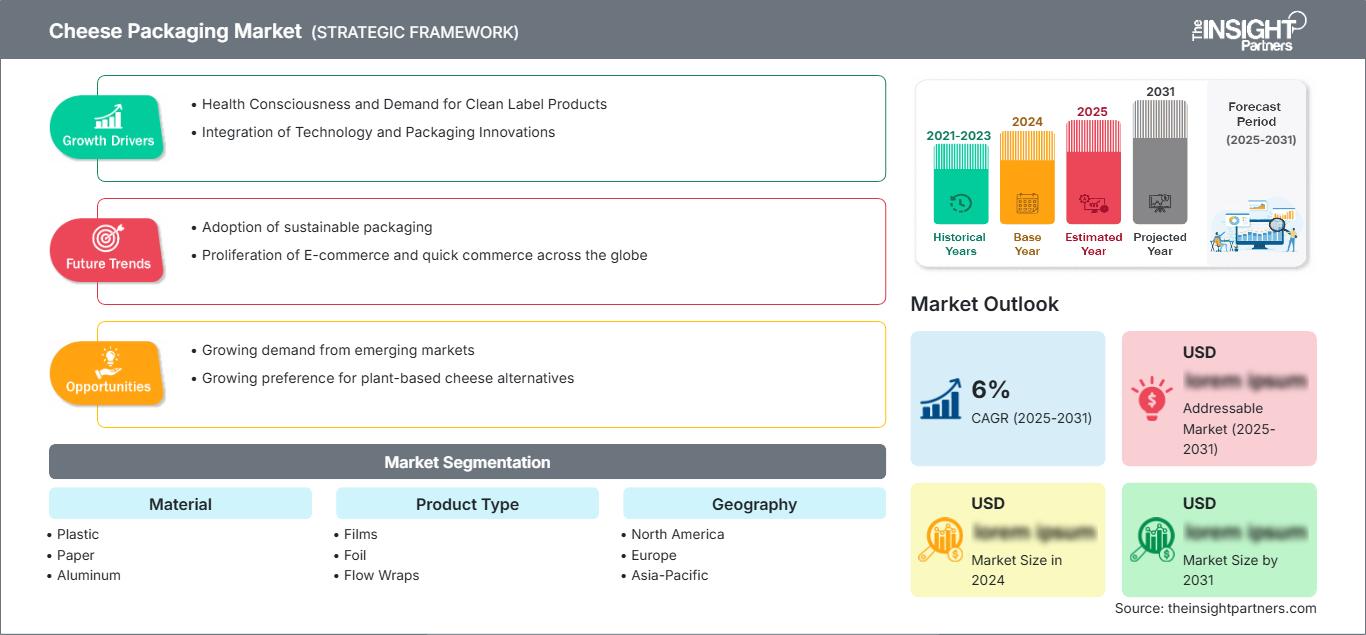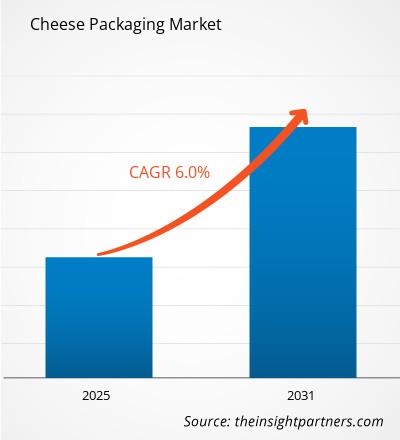Si prevede che il mercato del packaging dei formaggi registrerà un CAGR del 6% dal 2025 al 2031, con una dimensione del mercato in espansione da XX milioni di dollari nel 2024 a XX milioni di dollari entro il 2031.
Il mercato del packaging dei formaggi è segmentato in base al materiale e alla tipologia di prodotto. In base al materiale, il mercato è segmentato in plastica, carta, alluminio e vetro. In base al tipo di imballaggio, il mercato è segmentato in pellicole, fogli di alluminio, involucri flow-pack, buste e sacchetti e altri.
Scopo del rapporto
Il rapporto Cheese Packaging Market di The Insight Partners mira a descrivere il panorama attuale e la crescita futura, i principali fattori trainanti, le sfide e le opportunità. Ciò fornirà spunti a vari stakeholder aziendali, come:
- Fornitori/produttori di tecnologia: per comprendere le dinamiche di mercato in evoluzione e conoscere le potenziali opportunità di crescita, consentendo loro di prendere decisioni strategiche informate.
- Investitori: per condurre un'analisi completa delle tendenze in merito al tasso di crescita del mercato, alle proiezioni finanziarie del mercato e alle opportunità esistenti lungo la catena del valore.
- Enti di regolamentazione: per regolamentare le politiche e le attività di polizia nel mercato con l'obiettivo di ridurre al minimo gli abusi, preservare la fiducia degli investitori e sostenere l'integrità e la stabilità del mercato.
Materiale di segmentazione del mercato degli imballaggi per formaggi
- Plastica
- Carta
- Alluminio
- Vetro
Tipo di prodotto
- Film
- Lamina
- Involucri flow-pack
- Buste e sacchetti
Potrai personalizzare gratuitamente qualsiasi rapporto, comprese parti di questo rapporto, o analisi a livello di paese, pacchetto dati Excel, oltre a usufruire di grandi offerte e sconti per start-up e università
Mercato del confezionamento del formaggio: Approfondimenti strategici

-
Ottieni le principali tendenze chiave del mercato di questo rapporto.Questo campione GRATUITO includerà l'analisi dei dati, che vanno dalle tendenze di mercato alle stime e alle previsioni.
Fattori di crescita del mercato del packaging del formaggio
- Attenzione alla salute e domanda di prodotti a etichetta pulita: i prodotti con etichetta senza conservanti e additivi artificiali sarebbero preferiti, poiché i consumatori stanno diventando sempre più attenti alla salute. Questa tendenza aumenta la domanda di materiali ecologici e biodegradabili per il packaging. L'azienda risponde a questo cambiamento introducendo nuove confezioni che si prendono cura della qualità del formaggio e non si discostano molto dai valori di sostenibilità dei consumatori.
- Integrazione di tecnologie e innovazioni nel packaging: il confezionamento sottovuoto, il confezionamento in atmosfera modificata (MAP) e il packaging attivo migliorano la conservazione dei prodotti caseari. Le innovazioni nella tecnologia di confezionamento prolungano e garantiscono la sicurezza dei prodotti caseari, garantendo quindi un'ottima tenuta del mercato. Inoltre, stanno emergendo tecniche di imballaggio intelligenti che segnalano la freschezza in tempo reale e attirano l'attenzione della popolazione di consumatori high-tech.
Tendenze future del mercato del packaging del formaggio
- Adozione di imballaggi sostenibili: il packaging è fortemente orientato alla sostenibilità, con preoccupazioni ambientali e fattori legali che impongono questo cambiamento. I produttori preferiscono sempre più utilizzare materiali riciclabili, biodegradabili e compostabili. Attualmente soddisfano la richiesta dei consumatori di prodotti ecologici, ma l'obiettivo è anche un migliore profilo di responsabilità sociale d'impresa per i marchi.
- Proliferazione dell'e-commerce e del commercio rapido in tutto il mondo: l'e-commerce ha preso una velocità vertiginosa negli ultimi anni e questa crescita è stata alimentata in modo esponenziale dalla pandemia di COVID-19. Mentre si è al chiuso, le persone ordinano di tutto online, dai latticini ai formaggi, principalmente. I metodi di imballaggio devono essere garantiti per preservare l'integrità di un prodotto durante il trasporto o eventuali danni causati durante il trasporto. Gli imballaggi sigillati e a temperatura controllata diventeranno sempre più importanti per la sicurezza. Le aziende modificheranno il loro approccio al packaging e offriranno opzioni di sicurezza più semplici per i consumatori che acquistano online.
Opportunità di mercato per il confezionamento dei formaggi
- Crescente domanda dai mercati emergenti: le economie emergenti, principalmente nell'area Asia-Pacifico e in America Latina, offrono significative opportunità di crescita per il mercato del confezionamento dei formaggi. L'aumento del reddito disponibile, insieme al cambiamento delle preferenze alimentari, ha aumentato la domanda di consumo di formaggio in tali mercati. Le aziende possono sfruttare questa tendenza e offrire soluzioni di confezionamento adattate alle esigenze locali e ai meccanismi di distribuzione.
- Crescente preferenza per le alternative vegetali al formaggio: le alternative vegane al formaggio hanno guadagnato popolarità grazie alla crescente domanda di diete a base vegetale. Questo segmento è noto per la necessità di innovazione nel packaging, poiché i produttori saranno alla ricerca di materiali che preservino la freschezza e la qualità dei formaggi non caseari. Lo sviluppo di imballaggi speciali per tali prodotti consentirà ai marchi di attingere al crescente mercato dei prodotti lattiero-caseari alternativi.
Mercato del confezionamento del formaggio
Le tendenze regionali e i fattori che influenzano il mercato del confezionamento dei formaggi durante il periodo di previsione sono stati ampiamente spiegati dagli analisti di The Insight Partners. Questa sezione illustra anche i segmenti e la geografia del mercato del confezionamento dei formaggi in Nord America, Europa, Asia-Pacifico, Medio Oriente e Africa, America Meridionale e Centrale.
Ambito del rapporto sul mercato del confezionamento del formaggio
| Attributo del rapporto | Dettagli |
|---|---|
| Dimensioni del mercato in 2024 | US$ XX million |
| Dimensioni del mercato per 2031 | US$ XX Million |
| CAGR globale (2025 - 2031) | 6% |
| Dati storici | 2021-2023 |
| Periodo di previsione | 2025-2031 |
| Segmenti coperti |
By Materiale
|
| Regioni e paesi coperti |
Nord America
|
| Leader di mercato e profili aziendali chiave |
|
Densità degli operatori del mercato del confezionamento del formaggio: comprendere il suo impatto sulle dinamiche aziendali
Il mercato del packaging del formaggio è in rapida crescita, trainato dalla crescente domanda da parte degli utenti finali, dovuta a fattori quali l'evoluzione delle preferenze dei consumatori, i progressi tecnologici e una maggiore consapevolezza dei benefici del prodotto. Con l'aumento della domanda, le aziende stanno ampliando la propria offerta, innovando per soddisfare le esigenze dei consumatori e sfruttando le tendenze emergenti, alimentando ulteriormente la crescita del mercato.

- Ottieni il Mercato del confezionamento del formaggio Panoramica dei principali attori chiave
Punti di forza
- Copertura completa: il rapporto analizza in modo esaustivo prodotti, servizi, tipologie e utenti finali del mercato del confezionamento dei formaggi, offrendo una panoramica olistica.
- Analisi degli esperti: il rapporto è redatto sulla base della conoscenza approfondita di esperti e analisti del settore.
- Informazioni aggiornate: il rapporto garantisce la pertinenza aziendale grazie alla copertura di informazioni e dati recenti.
- Opzioni di personalizzazione: questo rapporto può essere personalizzato per soddisfare le esigenze specifiche del cliente e adattarsi in modo appropriato alle strategie aziendali.
Il rapporto di ricerca sul mercato del confezionamento dei formaggi può quindi contribuire a guidare il percorso di decodificazione e comprensione dello scenario del settore e delle prospettive di crescita. Sebbene possano esserci alcune valide preoccupazioni, i vantaggi complessivi di questo rapporto tendono a superare gli svantaggi.
- Analisi storica (2 anni), anno base, previsione (7 anni) con CAGR
- Analisi PEST e SWOT
- Valore/volume delle dimensioni del mercato - Globale, Regionale, Nazionale
- Industria e panorama competitivo
- Set di dati Excel
Report recenti
Rapporti correlati
Testimonianze
Motivo dell'acquisto
- Processo decisionale informato
- Comprensione delle dinamiche di mercato
- Analisi competitiva
- Analisi dei clienti
- Previsioni di mercato
- Mitigazione del rischio
- Pianificazione strategica
- Giustificazione degli investimenti
- Identificazione dei mercati emergenti
- Miglioramento delle strategie di marketing
- Aumento dell'efficienza operativa
- Allineamento alle tendenze normative






















 Ottieni un campione gratuito per - Mercato del confezionamento del formaggio
Ottieni un campione gratuito per - Mercato del confezionamento del formaggio